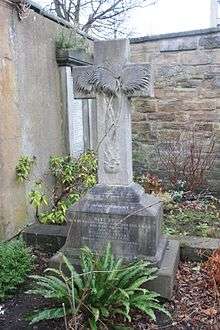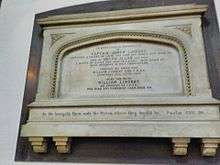William Lindsay (shipowner)
William Lindsay FRSE SSC (24 November 1819 - 20 February 1884) was a Scottish shipowner who served as Provost of Leith from 1860 to 1866. Lindsay Road in Edinburgh is named after him.[1]
William Lindsay FRSE SSC | |
|---|---|
 Lindsay's grave in South Leith. | |
| Born | 24 November 1819 |
| Died | 20 February 1884 (aged 64) Leith, Edinburgh, Scotland |
| Occupation | Shipowner, lawyer |
| Spouse(s) | Mary Weatherstone Bruce (m. 1844; died 1881) |
| Children | 3 |
| Parent(s) | James Lindsay Helen Allan |
| Relatives | Charles Augustus Carlow (grandson) |
As a lawyer he was responsible from framing the General Police and Improvement Act (Scotland) of 1869 which was known as the Lindsay Act.[2]
Life

He was born in 1819 on Coburg Street in North Leith. He was the son of Captain James Lindsay (d.1839), a shipmaster, and his wife, Helen Allan of Alloa.
He was apprenticed to Alexander Simson SSC nearby, at 38 Bernard Street[3] as a solicitor.
In 1860 he became Provost and Chief Magistrate of Leith and organised the remodelling of Leith Town Hall to accommodate a new court room and prison (still extant) and absorb a line of Georgian houses to the east to create Leith Police Station.
In 1864 he was elected a Fellow of the Royal Society of Edinburgh his proposer being Thomas Williamson.[4] From 1864 until death he left the legal world and started a local shipping company, owning several ships.
In 1875, he was living at Hermitage Hill in Leith, a large Georgian villa south of Leith Links.
He died on 20 February 1884. A memorial was erected to his memory in the south aisle of South Leith Parish Church.
Family
He was married to Mary Weatherstone Bruce (d.1881). They had three children: James William (b. 1849), Mary Weatherstone (b. 1851), and William Walter (b. 1854).
He was grandfather to Charles Augustus Carlow FRSE, the son of his daughter, Mary Weatherstone Lindsay (1851-1929).
Artistic Recognition
His portrait by John Horsburgh is held by the City of Edinburgh Council[5] at Leith Town Hall (now Leith Police station) along with a marble bust of him.
References
- http://www.leithhistory.co.uk/2005/04/15/the-lindsay-monumentsouth-leith-parish-church/
- http://www.leithhistory.co.uk/2005/04/15/the-lindsay-monumentsouth-leith-parish-church/
- Edinburgh and Leith Post Office directory 1835-6
- Biographical Index of Former Fellows of the Royal Society of Edinburgh 1783–2002 (PDF). The Royal Society of Edinburgh. July 2006. ISBN 0 902 198 84 X.
- https://www.artuk.org/discover/artworks/william-lindsay-18191884-provost-of-leith-18601866-93431